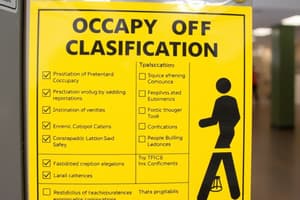Podcast
Questions and Answers
Which of the following is NOT one of the five building occupancies defined in the code?
Which of the following is NOT one of the five building occupancies defined in the code?
Refrigerants are grouped into safety groups based on which two factors?
Refrigerants are grouped into safety groups based on which two factors?
Which section of the code primarily covers the requirements for machinery rooms?
Which section of the code primarily covers the requirements for machinery rooms?
What do the regulations in section 7 address?
What do the regulations in section 7 address?
Signup and view all the answers
What do the rules in section 9 of the code refer to?
What do the rules in section 9 of the code refer to?
Signup and view all the answers
Which section of the code classifies refrigeration systems based on the method used for extracting heat?
Which section of the code classifies refrigeration systems based on the method used for extracting heat?
Signup and view all the answers
What is the classification of refrigerants based on toxicity and flammability?
What is the classification of refrigerants based on toxicity and flammability?
Signup and view all the answers
Which section of the code primarily deals with drawings, specifications, and data reports for refrigeration pressure vessels, piping, and fittings?
Which section of the code primarily deals with drawings, specifications, and data reports for refrigeration pressure vessels, piping, and fittings?
Signup and view all the answers
What does section 6 of the code primarily cover?
What does section 6 of the code primarily cover?
Signup and view all the answers
What do the rules in section 9 of the code refer to?
What do the rules in section 9 of the code refer to?
Signup and view all the answers
Which section of the code discusses the regulations regarding pressure vessel and compressor overpressure protection?
Which section of the code discusses the regulations regarding pressure vessel and compressor overpressure protection?
Signup and view all the answers
What is the classification of refrigerants based on toxicity and flammability?
What is the classification of refrigerants based on toxicity and flammability?
Signup and view all the answers
Which section of the code primarily covers the rules for charging and discharging refrigerants, system maintenance, and posting of instructions?
Which section of the code primarily covers the rules for charging and discharging refrigerants, system maintenance, and posting of instructions?
Signup and view all the answers
What are the five different building occupancies defined in the code?
What are the five different building occupancies defined in the code?
Signup and view all the answers
Which section of the code primarily covers the requirements for machinery rooms, including refrigerant leak detection systems and ventilation systems?
Which section of the code primarily covers the requirements for machinery rooms, including refrigerant leak detection systems and ventilation systems?
Signup and view all the answers
Flashcards are hidden until you start studying
Study Notes
CSA B52 Mechanical Refrigeration Code
- The CSA B52 Mechanical Refrigeration Code is revised every 3 to 5 years, and it's essential to refer to the most current Code on the CSA website.
- The code sections relevant to Power Engineers can be found in the PanGlobal Extract of CSA Standards.
Purpose and Scope
- The CSA B52 Code was developed to minimize the risk of personal injury by providing minimum requirements for the design, construction, installation, inspection, and maintenance of refrigeration systems.
- The code has two purposes:
- To provide for the safe design, construction, installation, operation, and repair of refrigerating and air conditioning equipment and systems, and related equipment.
- To promote uniform requirements among the provinces and territories.
Code Sections
- The scope lists the type of equipment to which this code applies, as well as the equipment to which it does not apply.
- The Reference Publications section lists all the publications referred to by CSA B52.
- The Definitions and Abbreviations section lists and defines terms related to refrigeration and air conditioning equipment.
- The System Selection and Application Requirements section discusses the requirements for system selection and application, including various system classifications.
Technical Committee
- The Technical Committee on Mechanical Refrigeration Code produces the B52 Code, consisting of representatives from:
- Provincial and territorial jurisdictions
- Professional engineers' associations
- Refrigerating and air conditioning institutes
- Other interested groups
Studying That Suits You
Use AI to generate personalized quizzes and flashcards to suit your learning preferences.
Related Documents
Description
Test your knowledge on the CSA B52 Mechanical Refrigeration Code and its importance in power engineering in Canada. Learn about the code's content, revisions, and its relevance to power engineers. Stay up-to-date by referring to the most current code on the CSA website.




